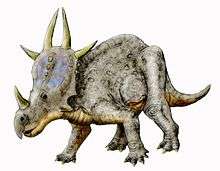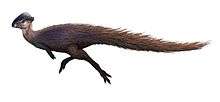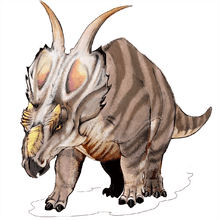Rubeosaurus
| Rubeosaurus Temporal range: Late Cretaceous, 74.6 Ma | |
|---|---|
 | |
| Holotype specimen | |
| Scientific classification | |
| Kingdom: | Animalia |
| Phylum: | Chordata |
| Class: | Reptilia |
| Clade: | Dinosauria |
| Order: | †Ornithischia |
| Family: | †Ceratopsidae |
| Subfamily: | †Centrosaurinae |
| Clade: | †Centrosaurini |
| Genus: | †Rubeosaurus McDonald & Horner, 2010 |
| Type species | |
| †Styracosaurus ovatus (Gilmore, 1930) | |
| Species | |
| |
Rubeosaurus (meaning "bramble or thornbush lizard") is a genus of ceratopsian dinosaur which lived in what is now North America. Rubeosaurus fossils have been recovered from strata of the upper Two Medicine Formation of the Upper Cretaceous of Montana, dating to 74.6 million years ago.[1]
History of discovery

The holotype specimen, USNM 11869, is composed of a partial parietal and was discovered by George F. Sternberg in 1928. A second specimen, MOR 429, is composed of a partial skull including a partial left premaxilla, co-ossified left and right nasals with horncore, partial left postorbital with horncore, and a nearly complete right parietal with two spikes. It was discovered in 1986.[1]
This genus was named by Andrew T. McDonald and John R. Horner in 2010, and the type species is Rubeosaurus ovatus. Formerly this species was assigned to Styracosaurus.[2] It is found as the sister taxon to Einiosaurus. It is notable for its large broad–based nasal horn and the ornamentation of its bony frill: there were one or two pairs of straight spikes on the edge, with the two spikes closest to the midline pointing so that they converged.[1] Immature specimens referred to a separate genus, called Brachyceratops, may be juvenile Rubeosaurus.[1][3]
Juvenile specimen
In 2007, Michael J. Ryan and colleagues suggested that Brachyceratops was possibly the juvenile form of Rubeosaurus.[3] A 2011 study supported this idea for the most mature specimen of Brachyceratops, USNM 14765, which shows one unique newly evolved feature (apomorphy) in common with Rubeosaurus to the exclusion of other centrosaurines. However, the same study suggested that because the holotype specimen of Brachyceratops is too incomplete and juvenile to preserve any determinable apomorphies, Brachyceratops must be considered a nomen dubium, and cannot be a senior synonym of Rubeosaurus.[4]
Classification


The cladogram presented here follows a 2012 phylogenetic analysis by Ryan, Evans & Shepherd.[5] Clade names within Centrosaurinae follow Fiorillo & Tykoski (2012).[6]
| Ceratopsidae |
| ||||||||||||||||||||||||||||||||||||||||||||||||||||||||||||||||||||||||||||||||||||
| |
See also
References
- 1 2 3 4 Andrew T. McDonald & John R. Horner, (2010). "New Material of "Styracosaurus" ovatus from the Two Medicine Formation of Montana". Pages 156–168 in: Michael J. Ryan, Brenda J. Chinnery-Allgeier, and David A. Eberth (eds), New Perspectives on Horned Dinosaurs: The Royal Tyrrell Museum Ceratopsian Symposium, Indiana University Press, Bloomington and Indianapolis, IN.
- ↑ Gilmore, Charles W. (1930). "On dinosaurian reptiles from the Two Medicine Formation of Montana". Proceedings of the United States National Museum. 77 (16): 1–39. doi:10.5479/si.00963801.77-2839.1.
- 1 2 Ryan, Michael J.; Holmes, Robert; Russell, A.P. (2007). "A revision of the late Campanian centrosaurine ceratopsid genus Styracosaurus from the Western Interior of North America" (PDF). Journal of Vertebrate Paleontology. 27 (4): 944–962. doi:10.1671/0272-4634(2007)27[944:AROTLC]2.0.CO;2. Retrieved 2010-08-19.
- ↑ McDonald, A. T. (2011). Farke, Andrew Allen, ed. "A Subadult Specimen of Rubeosaurus ovatus (Dinosauria: Ceratopsidae), with Observations on Other Ceratopsids from the Two Medicine Formation". PLoS ONE. 6 (8): e22710. doi:10.1371/journal.pone.0022710. PMC 3154267
 . PMID 21853043.
. PMID 21853043. - ↑ Ryan, M. J.; Evans, D. C.; Shepherd, K. M.; Sues, H. (2012). "A new ceratopsid from the Foremost Formation (middle Campanian) of Alberta". Canadian Journal of Earth Sciences. 49 (10): 1251. doi:10.1139/e2012-056.
- ↑ Fiorillo, A. R.; Tykoski, R. S. (2012). "A new Maastrichtian species of the centrosaurine ceratopsid Pachyrhinosaurus from the North Slope of Alaska". Acta Palaeontologica Polonica. 57 (3): 561. doi:10.4202/app.2011.0033.
| Wikimedia Commons has media related to Rubeosaurus. |


